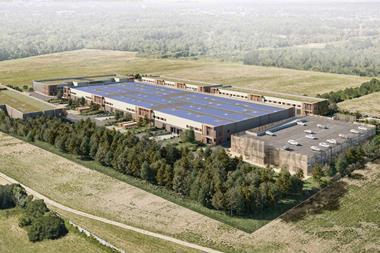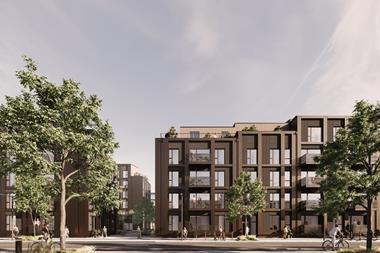The weight of capital attracted by fast economic growth has forced down yields across the region, but there is debate as to whether the change in market sentiment will reverse the trend, as Krystyna Krzyzak reports
Global credit crunch notwithstanding, 2007 was a record year for CEE real estate transactions. According to Karel Zeman, senior investment analyst at ING Real Estate Investment Management, Central Europe, this was partly due to the office sector driving volume. "In 2006 retail became the leading sector, but in 2007 offices returned to the picture, with retail still in the lead." German funds were also key in propelling investment flows. "German funds have a lot of equity, do not have to source finance externally, and can comfortably invest with relatively low yields," says Zeman.
"The most interesting aspect of the recent investment environment in the region has been the return of the German funds and the retreat of the highly leveraged buyers," adds Ermina Topintzi, Head of Real Estate Quantitative Research, RREEF.
"Traditionally, the profile of investors varies across the region, with more core and value-added investors from Austria, Germany, and the UK being more active in the more mature markets of Central Europe. The less mature markets farther to the east tend to attract more opportunistic investors given the emergent nature of these markets."
Fast economic growth typical of emerging economies has been a major driver. With the exception of Hungary, where the government is operating an austerity package designed to shrink the country's unacceptably high budget and current account deficits, the region experienced extremely fast GDP growth rates in 2007, as high as 10.4% in Slovakia.
All these countries have sucked in foreign direct investment which, in the case of office development, still means undersupply. According to ING's Zeman, vacancy rates for class A and B properties in the fourth quarter of 2007 ranged from 6% in Bratislava and 5.8% in Prague to 3.8% in Warsaw and 2% in Bucharest. In the case of Warsaw, year-on-year rent rises in the central business district soared by 40%, although this fell by only 5% for out-of-town properties.
Out-of-town developments are also set to drive the retail sector as the biggest cities get saturated with shopping centres. Zeman advises investors to look for prestige locations in strong regional catchment areas; an attractive mix of tenants, including fashion anchor outlets, and uncomplicated layouts. At GE Real Estate, which has 25 retail assets in the CEE region, Karim Habra, managing director for Central and Eastern Europe, adds that shopping projects must be selected on a case-by-case basis, and not just on supply statistics: "There is no middle ground. In the best schemes we see rents rising and in the worst they are going down."
The retail sector can in turn propel the logistics sector, although this is acknowledged as one of the more difficult correlations for investors to quantify correctly. Habra explains that when GE Real Estate and its joint venture partner Helios Phoenix signed their €175m Romanian development last year of seven warehouses across six cities, logistics was almost non-existent outside of Bucharest.
The residential sector is also prone to pitfalls. In the Bulgarian residential sector, meanwhile, the market for second homes has fallen through the floor according to Michael Rhydderch, partner, capital markets, at Cushman & Wakefield, with huge amounts of unsold stock in ski and coastal resorts. Most of the capital for these came from AIM-listed funds. While many investment fund managers have steered clear of the residential sector, GE Real Estate has been active in developing tailor-made properties for the mid-segment market in Poland and the Czech Republic, its two regional platforms, and plans to expand into Romania and Bulgaria. Good transport, amenities and greenery are key essentials according to Habra. In Poland it has developments for sale not only in Warsaw but in undersupplied cities such as Wroclaw and Poznan.
Poland continues to dominate the CEE real estate market, despite the volume of commercial property assets traded falling by 40% year on year in 2007 to €2.8bn, according to Cushman & Wakefield Polska's Marketbeat Poland - Spring 2008 report. Cushman & Wakefield values the Polish property market size at €110bn, compared with €52bn in the Czech Republic, €45bn in Hungary, €30bn in Romania, €20bn in Slovakia and €10bn in Bulgaria. The country scores not just by dint of being the biggest CEE country in terms of population (38.5m), but also in having many substantially sized cities, as only 1.7m live in the capital Warsaw.
The retail market was the most dynamic sector, with 740,000 m² of space added last year, almost 40% of that in medium-sized towns, in 30 transactions. Deals included the €146m acquisition of the Wola Park Shopping Centre in Warsaw by French fund AEW, and the €232m countrywide acquisition of five centres by Macquarie Countrywide Trust. Although average rental values fell, this largely reflects the many developments in medium-sized towns.
The office market was visibly affected by credit constraints, with the value of deals in the second half of 2007 totalling only €248m compared with €883m in the first. However, demand remained brisk, especially in the secondary cities where foreign investors locating or relocating their business processing centres have been partly behind the expansion.
The industrial market, by contrast, remained more subdued, hampered by a lack of quality investment projects, although Poland is now the investors' and developers' first choice for logistics centres. The regional cities are currently spearheading growth, with Warsaw now accounting for less than 50% of modern warehouse stock. New developments in the pipeline include the port city of Szczecin as well as Bydgoszcz and Torun.
In 2012 Poland co-hosts the European Football Championship with Ukraine, and this is creating a boom in hotel construction and redevelopment, in addition to that generated by the tourist boom following the country's EU entry in May 2004. The number of tourists is estimated to rise from 15.7m in 2007 to some 21m by 2012. There is a shortage of hotel accommodation outside the main cities, and a nationwide shortage of economy class hotels nationwide. New builds and modernisation are set to add up to 30,000 more rooms by 2012.
Unlike other Polish real estate sectors, the residential market saw an increase last year over the previous year of 15%, to 135,000 apartments. Most took place in the so-called ‘first wave' markets of Warsaw, Krakow and Worclaw, with Warsaw and Wroclaw increasingly favouring mixed-use properties. Although the residential boom appears to be over for now, there is still high consumer demand for lower-priced properties.
The global credit crunch now raises questions whether other CEE property booms are over, or whether the region can withstand the pressures. "With a global economic slowdown clearly underway, growth projections for 2008 are being reduced across all major economies and the CEE region will not be unaffected," warns Pierre Cherki, co-CEO, RREEF Europe. "As the economy of the region slows, it follows that most of the markets will slip from growth to post-growth phases and in some cases in contraction, like in the case of Warsaw which faces a large supply pipeline. We will therefore monitor this region closely over the coming two years and be very selective in our choice of assets."
The impact of the credit crunch is discernible but by no means uniform. Karel Zeman expects a resultant upward yield shift of up to 15 basis points for prime and a bit more for secondary location properties. While the effects are not so pronounced in, say, the Czech Republic and Poland, he remains more pessimistic on Hungary, with its high proportion of foreign-owned debt, and Romania, although he believes that even there yields will not grow significantly.
Alan Patterson, head of European research and strategy at AXA-REIM, believes that there may be some disconnection between the effects of the credit crunch in western and eastern European economies. Companies in western Europe may come under even greater pressure to reduce their costs and relocate their operations in the lower labour-cost CEE, generating more demand for industrial and office property. The CEE member states of the EU are also receiving substantial structural financing over the coming years for infrastructural and other developments. Patterson cites the case of aid flows into Northern Ireland, which enabled its property market to escape the UK recession of 1991-92.
The office sector appears among the most vulnerable. "As the economy of the CEE region slows, it follows that most of the office markets will slip from growth to post-growth phases. Warsaw might have performed exceptionally well in 2007, with office rents rising by over 40%, but is set to revert to sub-inflationary growth until the end of the decade, due to a large amount of space expected to come in 2008-09," explains RREEF's Topintzi. "In Prague, the office market is transitioning from growth to post-growth stages. Unlike Moscow, however, the cyclical swings in this market will be less dramatic, with rental growth slowing in the outer years of the forecast window but not likely to reverse. Budapest's office market cycle runs somewhat counter to the other cities in the CEE region."
In Budapest, with an office vacancy rate of 10.8%, the business district is neither centralised nor cohesive. "This limits the benefit of the kick-start from external businesses to stimulate others to raise their standards," notes Alan Patterson.
Karim Habra is somewhat more bullish on the region's office sector. "We're positive on rental growth in Warsaw and Prague city centres," he explains. GE Real Estate and Tishman International of Los Angeles is currently building Sofia Airport Center, a €250m, 180,000m² office, hotel, logistics and light industrial development 300m from the new airport.
The crunch may also reverse the yield compression that has been one of the notable features of the CEE real estate market, especially in Bulgaria and Romania, where the move from agrarian to service economies occurred later than in the first wave of east European EU member states. "The progression in real estate pricing has been outstanding," notes Michael Rhydderch. In the first-wave countries yields fell from 10% to 6% over eight years; in Bulgaria and Romania they went from 9% to 6% in the space of 18 months, leading, for instance, to potential huge oversupply in the Romanian retail market. In 2007 the Romanian retail sector attracted more than €900m of total investment. "Many feel that the degree to which retail yields have compressed in Bulgaria and Romania is not justified," Rhydderch adds.
RREEF's Topintzi adds that the risk of overheating is probably the greatest in some of the Central European office markets, where cap rates have compressed by more than 250bps over the three years to end 2007, to sub-5.5%. "However, towards the start of 2008, there have been signs of cap rates levelling off. Following the sharp correction in property yields in the UK, prime office yields in London City currently stand at 5.25%, similar to those found in Prague and in Warsaw. This situation questions the rationale of accepting such low cap rates in markets like the CEE, which are faced with limited rental growth prospects and liquidity constraints relative to those in Western Europe. We therefore think that the markets in the CEE are up for correction over the next two years."
Meanwhile Rhydderch questions why investors should expect a significant premium in many of the CEE countries. "There is no substantial risk in liquidity, transparency, pricing, volatility, quality or supply. Warsaw is less volatile than London," he argues.
Other factors complicate yield expectations. AXA-REIM's Patterson says that the region does carry its investment risks, including poor yield data and tax and political uncertainties. With the rapid pace of development, and demand exceeding supply, especially in the office sector, rental value has not yet stabilised. Meanwhile relatively new buildings can be quickly rendered obsolete. "Investors may get a good performance in the short term, but not in the long term," he cautions.
While the coming year is set to be more challenging, Karim Habra believes that investors will become more realistic. "Towards the end of 2007 investors started focusing on real estate fundamentals such as rental growth and value creation opportunities rather than just cap rate compression," he says. "Investors are being more selective and more cautious. There has been a small impact on Class B properties whereas before there wasn't much differentiation from Class A properties, which is altogether a healthier situation. It's also positive for us," he adds. "We are now seeing developers who need strong capital partners like us."












